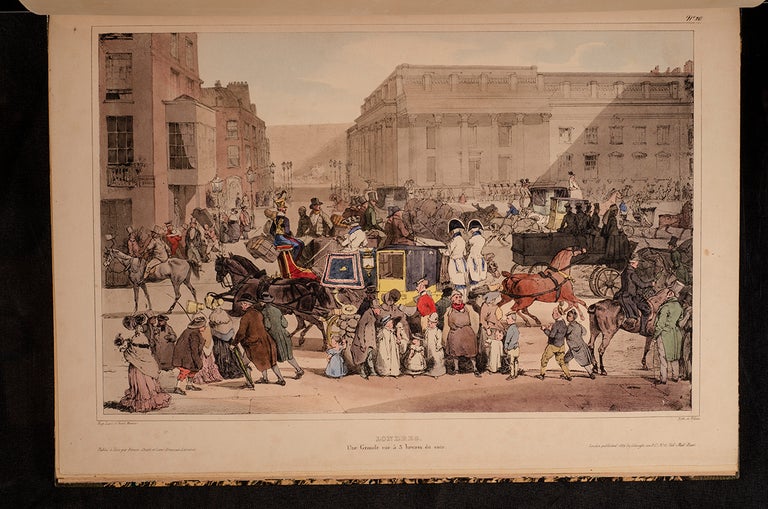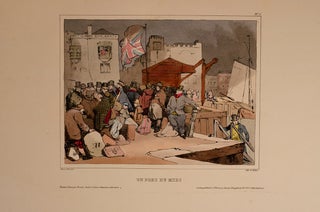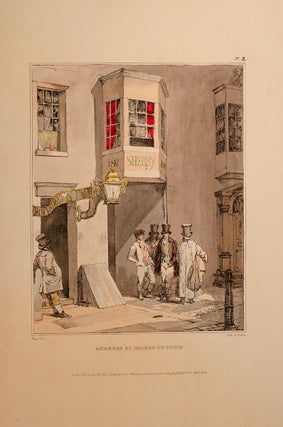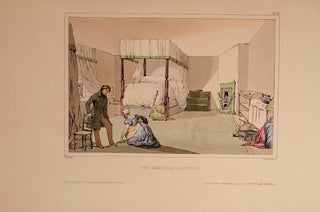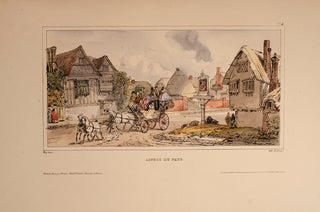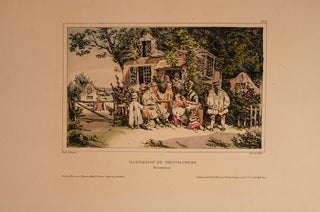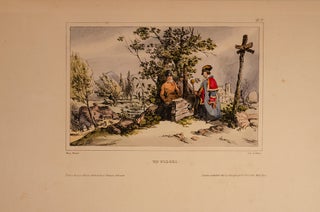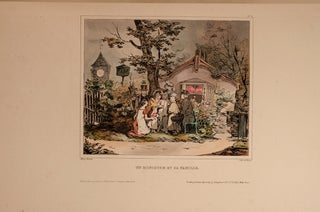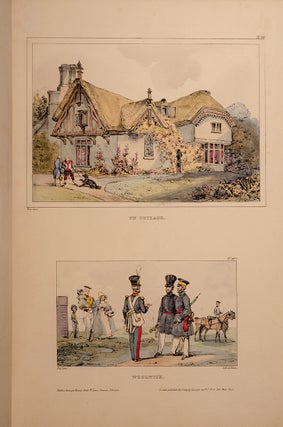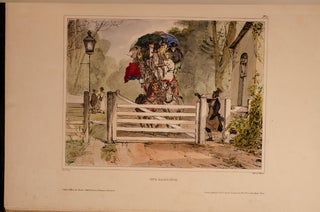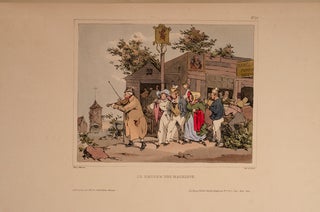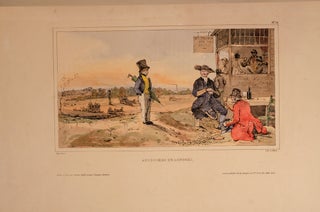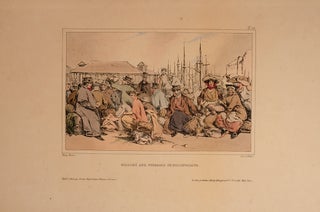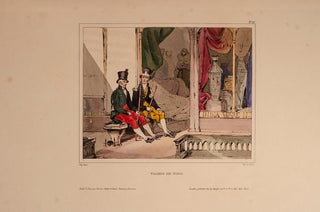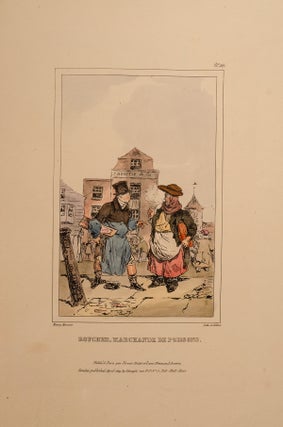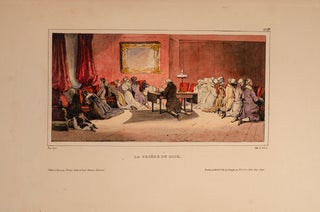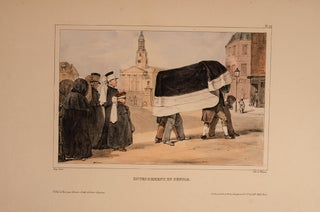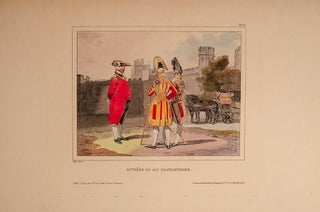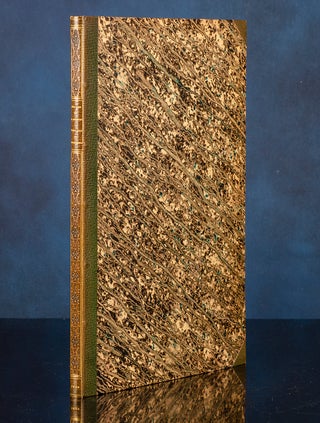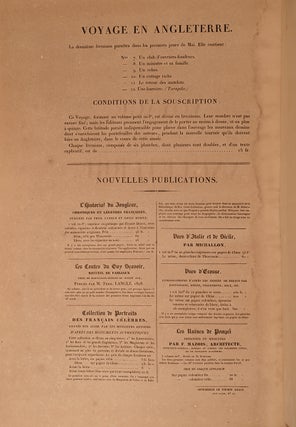Voyage en Angleterre,
Paris: Publié par Firmin Didot frères, et Lami-Denozan [and] London: Colnaghi Son et Co.…, 1829. Item #05349
Twenty-Eight Hand-Colored Lithographed Plates Depicting
Lami and Monnier’s “Travels in England”
Complete with the Very Scarce Additional Four Plates
[LAMI, Eugène, and Henry Monnier, illustrators]. Voyage en Angleterre, par Eug. Lami et H. Monnier. Paris: Publié par Firmin Didot Frères, et Lami-Denozan [and] London: Colnaghi Son et Co.…, 1829-[1830].
First edition, complete with the text and the four additional plates.
Title from front wrapper. Large folio (16 3/4 x 11 3/4 inches; 426 x 298 mm.). [viii]. Twenty-eight numbered hand-colored lithographed plates, seventeen signed by Lami, ten signed by Monnier, and one (plate number 20 "Londres") signed by both Lami and Monnier. Plates lithographed by Villain. All plates and text leaves mounted on guards. Complete with the four leaves of letterpress descriptive text. Small neat marginal repairs to plate number two (1 inch) and plate number 9 (5/8 inch). Preliminary text leaves a little foxed, the superb hand colored plates clean and fresh.
Late nineteenth century half green straight-grain morocco over marbled boards, ruled in blind. Smooth spine elaborately tooled in gilt and blind and lettered in gilt. Marbled endpapers, top edge gilt. Original gray front and back printed wrappers from part 1 bound in. Wrappers expertly restored on inner blank margins. The four additional hand colored lithographs are laid in at the end and as per Gordon Ray are slightly smaller in size (10 1/8 x 15 3/4 inches; 270 x 400 mm.). A wonderful and very large example. (Michael Sadleir’s copy, described in Ray, measured 16 1/2 x 15 3/4 inches; 11 1/4 inches).
Originally published in four parts, each with one leaf of descriptive text and six plates. This copy includes the four supplementary plates, described in Ray as being “in smaller format, with the original wrapper imprint reading: Paris, Gihaut frères.” According to Vicaire, these plates were published without descriptive text and are numbered and captioned as follows: No. 6. “Club de Fermiers;” No. 27. “Crescent-Park;” and No. 28. “Un Salon;” and No. 29. “Un Trottoir dans la Cité.” Colas and Hiler both call for twenty-four plates.
“This elegant and brilliant painter [Eugène Lami, 1800-1890] devoted much of his time to lithography between 1817 and 1833. The son of an Empire bureaucrat, he grew up in Paris. Beginning in 1815, he studied painting with Horace Vernet and afterwards in the studio of Baron Gros…To support himself he made lithographs for several albums, including in 1822 a Collection des uniformes des armées françaises, de 1791 à 1814…Lami paid his first visit to England in 1826, during which he drew the sketches which resulted in his Souvenirs de Londres…He fell in with Henry Monnier, already an expert in things English, and under his guidance comprehensively explored London and the countryside. Indeed, Monnier provided more than a third of the twenty-eight designs which make up Lami’s finest album, the Voyage en Angleterre. It is here that for the first time Lami struck his distinctive note in lithography. These precise and sparkling plates, which show England in its most attractive aspects, brought the lithographic recording of the passing scenes to an unprecedented level of grace and refinement” (Ray, The Art of the French Illustrated Book, p. 203).
“Lami’s lithographs in this album have a salience and solidity otherwise unmatched in his work, and the bright yet harmonious coloring with which they were completed makes them hardly distinguishable from watercolors. The series also has the interest of showing English life and customs as seen through the fresh eyes of two shrewd foreigners. They emphasize the freedom and well-being of the people, which combine to ensure ‘order in…apparent disorder’ (text for no. 20). Coachmen, turnpike keepers, footmen, merchants, farmers, and workmen all behave with ease and confidence. The many glimpses of country and village life exude tranquillity. The social order of which these men and women are a part is fixed but not oppressive. In ‘Evening prayer’ (no. 17), there is a solidarity about the household at its devotions, even if the family takes its ease on one side of the room, while the servants are huddled together on the other. The culminating plate of the album, in which both artists had a hand, shows Parliament Street in London during the evening rush hour (no. 20). It is a microcosm of the city’s ‘busy scene of crowded life,’ soldiers drilling at the rear, carriages criss-crossing, and all sorts and conditions of men going their various ways in the foreground” (Ray, The Art of the French Illustrated Book, pp. 204-205).
“Monnier [1799-1877] grew up in the Parisian bourgeois world, where his father was an employee like those he was later to depict with such mastery in his lithographs…After he finished his education, he served as a notary of Justice, where he seems to have been valued chiefly for his handwriting…He then studied in the ateliers of Girodet and later Gros, where he learned lithography and became the friend of Bonington and Lami. His first lithographs, of which the album Modes et ridicules of 1825 is representative, are grotesque exaggerations in the manner of Rowlandson that call to mind J.-B. Isabey’s Caricatures de J.J. [see Ray 101] and Lami’s Les contretemps [see Ray 137]. Between 1825 and 1827 Monnier passed much of his time in London, where he collaborated with Lami in what was to become the Voyage en Angleterre. On his return to Paris he embarked on a series of albums in which he recorded the manners and humors of the city with unprecedented profusion. Between 1826 and 1830 he satisfied the insatiable demand for his designs with almost 500 lithographs, nearly all of which were drawn with a pen and colored by hand” (Ray, The Art of the French Illustrated Book, p. 199).
“The popularity of the paintings of Constable and Bonington, among others, made England attractive to artists in the 1820s. After leaving Gros’ atelier, Monnier crossed the Channel, perhaps with the specific aim of studying aspects of lithography being developed there, and almost certainly to make contact with English caricaturists. In 1826 and 1827 he worked for the London publisher Colnaghi on the project Voyage en Angleterre, and collaborated with his friend Eugène Lami on the work. In contrast with Lami’s attention to high life, Monnier’s subjects focused more on the lives and types of the common people, such as the fishmongers of Billingsgate” (Beatrice Farwell, The Charged Image, p. 114).
The plates are captioned: No. 1. “Un Port du Midi;” No. 2. “Auberge et Maison de Poste;” No. 3. “Une Chambre d’Auberge;” No. 4. “Aspect du Pays;” No. 5. “Habitation de Cultivateurs. Vue extérieure;” No. 6. “Une Petite Ville de Province. (Comtés du Midi);” No. 7. “Un Pilori;” No. 8. “Un Ministre et sa Famille;” No. 9. “Un Relai;” No. 10 and 10 bis. “Un Cottage” and “Woolwich;” No. 11. “Une Barrière;” No. 12. “Le Retour des Matelots;” No. 13. “Approches de Londres;” No. 14. “Marché aux Poissons de Billingsgate;” No. 15. “Valets de Pied;” No. 16. “Boucher, Marchande de Poissons;” No. 17. “La Prière du Soir;” No. 18. “Peuple de Londres. Discussion orageuse;” No. 19. “Rentrée des Watchmen;” No. 20. “Londres. Une Grande rue à 5 heures du soir;” No. 21. “Un Marchand de Poissons;” No. 22. “Officiers des Gardes et Officiers du Régiment des Rifles;” No. 23. “Enterrement du Peuple;” and No. 24. “Livrées du Roi d’Angleterre.” Plate No. 2 is incorrectly numbered 3, plate No. 6 is incorrectly numbered 7, plate No. 17 is incorrectly numbered 7, plate No. 18 is incorrectly numbered 17, and plate No. 22 is unnumbered.
The four additional plates are capyioned: No. 6. “Club de Fermiers;” No. 27. “Crescent-Park;” and No. 28. “Un Salon;” and No. 29. “Un Trottoir dans la Cité.”
Colas 1748 (calling for twenty-four plates and four unnumbered leaves). Hiler, p. 524 (calling for four leaves and twenty-four plates). Lipperheide 995. Ray, The Art of the French Illustrated Book, 139. Vicaire V, cols. 1-3.
Price: $9,500.00

 I have been in the rare and antiquarian book business for over forty years; my family has been in the rare books business since 1876. Rare books are in my blood.
I have been in the rare and antiquarian book business for over forty years; my family has been in the rare books business since 1876. Rare books are in my blood.
